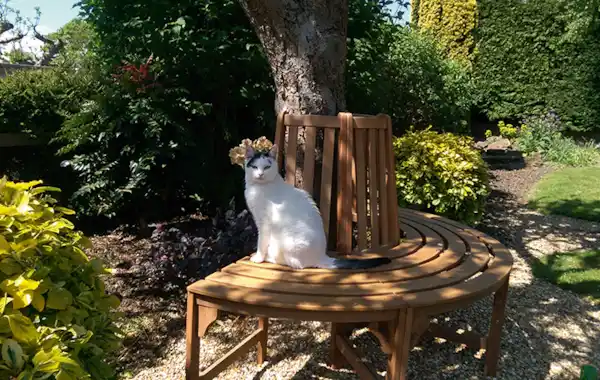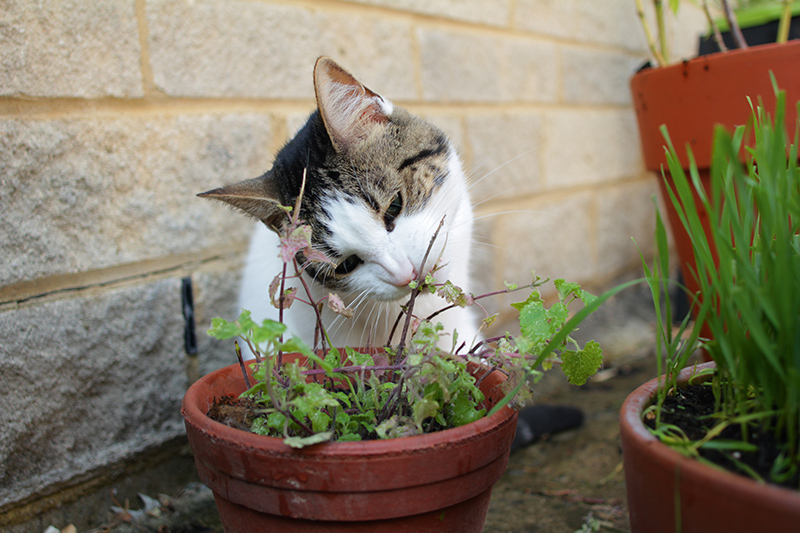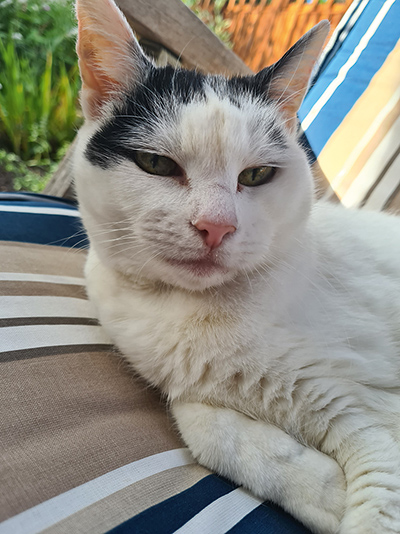We all look forward to the hazy days of summer but at this time of year, we need to pay extra attention to our cats’ welfare and comfort. Alison Gallagher-Hughes provides some top tips for cool cats.
Cool for cats
Imagine sunbathing in a fur coat...yes, mad isn’t it? But our cats effectively do this when they venture out on a hot, sunny day. Cats lose most of their body heat through their paws and nose, so it’s essential to help keep them cool. Here are some top tips:
● Cats tend to be sensible creatures; they will naturally seek out shady spots to regulate their own body temperature but why not give them a helping hand? There’s a great range of cat houses on the market or consider keeping open garden parasols, erecting a canvas gazebo, or simply put out a few cardboard boxes weighted with stones.
● Try to restrict access to the garden during the hottest times of the day (between noon and 3pm) and provide some damp towels on which they can moisten their paws.
● It’s important to keep our cats well-groomed at this time. During the early part of the summer, they will benefit from a good brush to remove their winter undercoat. If you have a senior cat or one with a medical condition, this is particularly important as they tend to groom themselves less frequently. Long-haired varieties may also benefit from a trim.
● In the house, keep the air flowing where your cats rest. A carefully placed electric fan will help them feel more comfortable.
● If you are going away this year, make sure that you plan ahead and make arrangements for the care of your cats, whether that’s in a cattery, by a cat-sitter, or with a friend in your home.

Plan well in advance if you want to put your cat in a cattery while on holiday.
● Ice cubes can be a great plaything for cats. Pop them on a hard floor and watch them push and pounce on them. As well as cooling down their paws, they provide enrichment on days when it’s best to keep your cat indoors and out of the heat.
● Try making an ice balloon — part fill an inflated balloon with water, freeze, pop the balloon, and add the frozen contents to thaw slowly in your cat’s water bowl.
● There are a wide range of cooling mats available to buy but placing freezer blocks or pads (well wrapped in a blanket) in your cat’s favourite spot will have a similar effect.
Make sure any plants you have are cat-friendly.
Keeping your cat healthy
● Cats can get sunburnt, especially if they have light fur. Apply sun cream to areas that are most exposed, such as the end of the nose and tips of the ears where fur can be more sparse. Buy a titanium dioxide-based sun cream that does not contain Zinc Oxide. Ask your vet to recommend a pet-friendly brand.
● Staying hydrated in the heat is also very important. One bowl is not enough — encourage cats to drink more by placing water bowls around the garden and in the shade. Keep them topped up — water can evaporate in the heat — and consider using a water fountain which can tempt them to drink more.
● Over time, we acquire plants for our gardens, often choosing them for their beauty or scent. As flora starts to emerge, check your garden and remove plants such as lilies — the leaves, flowers, and pollen are highly poisonous to cats even in miniscule quantities.
● Consider creating a scented garden. Some pets enjoy honeysuckle and avender. Many love catnip or catmint, and often use the plant as a sleeping cushion.
● Curiosity often gets the better of our furry friends and at this time of year, many of us leave open doors and windows, along with sheds and garages. It’s perhaps no surprise that many cats go missing at this time of year
— getting locked in when things get shut up at night. If your cat does go missing, start the search by asking your neighbours to check their outbuildings...and even their homes.
● The hot weather also brings an increase in parasites. Ensure that your cat receives regular flea treatments and check them for ticks by running your hand over their bodies to identify anything that has ‘got on board’. Ticks are common in woodland, grassland, and heath areas, but can also be found in your garden if you live in an area with lots of wildlife.
Cat ticks transmit microbes that cause diseases, such as Lyme disease and babesiosis, so early removal is important. If you find a tick on your cat, use a tick remover to get underneath it and twist it off.
● Watch out for signs of sunstroke: agitation, rapid breathing, skin that is hot to the touch, drooling, or vomiting.
If you have any concerns contact your vet immediately — speedy attention is essential. Pay particular attention to elderly or overweight cats.
Try to restrict your cat’s access to the garden during the hottest times of the day.
Viewpoint
Alison says: “Summertime is always a challenge in our household. With four senior cats — including two that are mainly white — I am always keeping an eye on their welfare.
“I put an electric fan in their sleeping room to keep them comfortable and minimise the heat of the day. Regular grooming and an application of sun cream every morning is a must.
“Our girls are particularly susceptible to the rays, the white fur is very sparse on their ears, so I apply a high factor sun cream. This coats the skin well and doesn’t rub off easily but when they roll around on the soil, it does tend to ‘cement’ on — not pretty but an effective sun block.”










